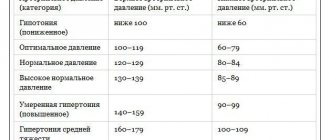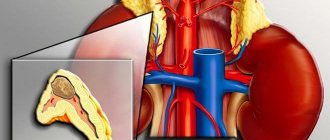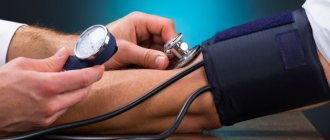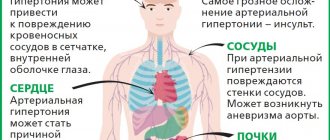The first drug with 2000% bioavailability
As long as you wait, your chances of getting rid of hypertension are decreasing!
To learn more…
Almost every person experiences high blood pressure at least once in their life. If this phenomenon is observed for a long time, then hypertension is diagnosed. The main sign of this pathological condition is considered to be an increase in blood pressure to 140/90 mmHg. Art. and higher. But what does pressure 150 to 130 mean? An increased lower indicator indicates the presence of disorders in the body that need to be urgently detected and eliminated.
Normally, lower (diastolic) pressure should be in the range of 65-90 mmHg. Art. Therefore, significant excess of the norm is cause for concern. A slight increase in diastolic blood pressure may occur throughout the day due to stress, physical or emotional stress, which is normal and does not require therapy. But if the numbers exceed 100 mm Hg. Art. and are observed repeatedly, this means the presence of serious problems.
What does high blood pressure mean?
The blood pressure level consists of two values: upper (systolic) and lower (diastolic) pressure. The upper value is called cardiac pressure and refers to the volume of blood that is pushed out by the contracting heart muscle. Normally it should be 120 mmHg. Art. The lower value is responsible for vascular tone and indicates the degree of relaxation of the heart muscle. It is also called renal pressure because it affects the health of the kidneys. Ideally, the lower reading should be 80-85 mmHg. Art.
Small deviations to a smaller or larger direction are allowed, especially in old age. But if diastolic blood pressure is 90 mm Hg. Art. and more, this is considered a sign of arterial hypertension. Taking into account the values of renal pressure, 3 stages of the development of hypertension are distinguished. If it is more than 110 mmHg. Art., then a severe degree of the disease is diagnosed. Often, with hypertension, both blood pressure values increase, but sometimes there are exceptions, and only the upper or lower value increases.
What does pressure 160 to 130 mean?
The norm for different age categories varies somewhat, but the ideal average reading is considered to be a pressure of 120/80 mmHg. Art. Blood pressure values within the range of 100-139/60-89 mm Hg are also allowed. Art. But this is only provided that the person feels good. Each man has his own ideal pressure at which he feels normal. For one person, blood pressure 130/85 will be normal, but for another it will be the reason for poor health. With age, a slight increase in values is allowed, which is also not considered a pathology. But in any case, if the upper pressure is 140 mm Hg. Art. and higher, and lower - more than 90 mm Hg. Art., then arterial hypertension is diagnosed.
Increased systolic (upper) blood pressure is common. But if there is a significant increase in diastolic (lower) blood pressure, then some people do not know what to do. If the tonometer repeatedly shows 160/130 mmHg. Art., then you need to urgently consult a doctor for a thorough examination, since this means the development of a moderate stage of hypertension. That is, this means already formed arterial hypertension, which has an adverse effect on the entire body. If such a pathological condition is detected, it is necessary to begin treatment as soon as possible, consisting of taking medications and changing lifestyle. This is necessary to prevent the progression of the disease and the development of serious complications.
Reasons for pressure 150 to 130
It is important to know!
STILL STRUGGLE WITH ARTERIAL HYPERTENSION INCORRECTLY? The first bioavailable drug with proven effectiveness Read more »
Lower blood pressure decreases due to narrowing of the renal artery. One of the most important functions of the kidneys is the regulation of blood pressure in the vessels. And if the renal artery narrows, the volume of blood entering the kidneys also decreases. As a result, the kidneys secrete special substances that retain sodium, thereby increasing blood volume, and also constrict blood vessels, causing an increase in blood pressure. The reasons for pressure 150 to 130 are very diverse. If primary hypertension is diagnosed, it is often not possible to determine the cause of its origin, since the following factors can provoke this condition:
- poor nutrition;
- physical or mental stress;
- stress or anxiety;
- emotional stress;
- bad habits: smoking, drinking alcohol;
- lack of sleep;
- long-term use of oral contraceptives;
- avitaminosis;
- sudden change in weather;
- passive lifestyle.
Also the pressure is 150/130 mmHg. Art. may be caused by hereditary predisposition, obesity or excessive consumption of salt and cholesterol. Secondary (symptomatic) hypertension is often diagnosed, the development of which may be caused by the following pathological conditions:
- heart defects;
- arrhythmia;
- diabetes;
- diseases of the endocrine system;
- pathologies of the kidneys or adrenal glands;
- pituitary diseases;
- atherosclerosis;
- oncology.
Fluid retention in the body is also another cause of pressure 150/130 mm Hg. Art. This condition can occur during pregnancy or menstruation, as well as due to overeating. An allergic reaction or extreme heat can also lead to fluid retention and increased blood pressure. It was noted that increasing diastolic pressure is the priority of men, while women predominantly face an increase in upper blood pressure. Often a pressure of 150 to 130 is an error. Such high readings may occur due to a malfunction of the tonometer. Therefore, you should not take any measures to lower blood pressure without repeating measurements using another device. If you feel very bad, you should call an ambulance and take a sedative.
Symptoms of pressure 150 to 130
High blood pressure is often discovered by chance, during a routine physical examination or during the diagnosis of another disease. In the initial stages of development, the disease is asymptomatic, which makes timely detection of the problem difficult. Therefore, most often hypertension is detected already at stages 2 or 3. With blood pressure 150 to 130 mm Hg. Art. the person feels overwhelmed and weakened. Even if increased diastolic pressure is not accompanied by any symptoms, it negatively affects the entire body.
A pressure of 150 to 130 is accompanied by intense work of the heart, preventing it from relaxing. This provokes a disruption of blood flow in the heart, as a result of which the blood vessels become more permeable and less elastic. These changes in the body are accompanied by the following symptoms:
- dizziness, headache;
- flashing “flies” before the eyes;
- numbness of fingers;
- sleep disturbance;
- facial redness;
- noise in ears;
- blurred vision;
- sleep disturbance;
- cardiopalmus.
In addition, at a lower pressure of 130 mm Hg. Art., a person becomes insecure, he constantly has a feeling of guilt, and there are frequent mood swings. Such people cannot express their opinions and do not have a clearly defined life goal. Without adequate therapy, the disease progresses, more irreversible pathological changes occur in the body, blood clots begin to form in the heart muscle, and various serious complications develop.
How does pressure of 160 to 130 manifest itself?
A persistent increase in blood pressure to 160 to 130 or more indicates the presence of stage 2 hypertension. This stage of the disease is rarely asymptomatic, although this also happens. Hypertension, which does not manifest symptoms, is considered a more dangerous condition because it is difficult to diagnose in a timely manner. Often the problem is discovered by chance, during a regular medical examination. At a pressure of 160/130 mm Hg. Art. the following symptoms occur:
- noise in ears;
- headache, dizziness;
- darkening of the eyes;
- “flies” flashing before the eyes;
- dyspnea;
- chills;
- cardiopalmus;
- nausea, vomiting;
- numbness of fingers;
- deterioration of memory, vision;
- swelling of the face and limbs;
- pulsation in the head;
- heavy sweating;
- facial hyperemia;
- pain in the back of the head at night or immediately after waking up from sleep.
With a constant increase in blood pressure to 160/130 ml Hg. Art. Irreversible changes begin to occur in the body, as a result of which the symptoms become more pronounced. Sometimes patients complain of heart pain. Such painful sensations can appear even at rest and last from a couple of minutes to several hours. And taking Nitroglycerin does not help eliminate discomfort. In addition, there is increased irritability, mood swings, drowsiness or agitation.
Consequences of pressure 150 to 130
When diastolic pressure increases, due to certain changes in the body, the heart is forced to pump blood more intensively. This can result from disruption of the functioning of the circulatory and vascular system. All this has a negative impact on the blood vessels, causing slow wear and tear of the cardiovascular system. As a result, a heart attack or stroke occurs. Another unpleasant consequence of a pressure of 150 to 130 is vascular atherosclerosis. Cholesterol is deposited on the walls of blood vessels and plaques form. Blood flow is disrupted, causing blockage of blood vessels.
The condition of blood vessels depends on renin, which is produced by the kidneys. Therefore, if the lower blood pressure increases to 130 or more, this indicates problems with the kidneys. Due to an incorrect lifestyle, the kidneys are not able to function normally, which has a negative impact on the entire body. Kidney failure often occurs, which leads to gradual poisoning of the body. The heart muscle contracts worse, blood stagnation occurs, resulting in the development of cardiovascular failure. If treatment is not started, memory and intellectual abilities may be impaired.
Possible complications of pressure 160 to 130
Blood pressure readings are 160 to 130 mm Hg. Art. They are dangerous not only due to the occurrence of a number of unpleasant symptoms, but also the development of serious complications that pose a threat to human health and life. Due to the constant increase in pressure, the vessels become less elastic and are unable to expand normally. Because of this, the heart muscle has to put in a lot of effort to push blood through the narrow arterial lumen. All this ultimately leads to rapid wear and tear of the heart, its hypertrophy, which leads to the development of various complications. Chronic pressure 160 to 130 mmHg. Art. dangerous due to the following complications:
- cardiac ischemia;
- heart attack;
- stroke;
- arrhythmia;
- heart or kidney failure;
- vascular atherosclerosis.
If timely and adequate treatment is not started, there is a high probability of impaired or loss of vision due to hemorrhages in the fundus. There is also a high risk of changes in the lungs. All these complications without immediate medical assistance can lead to disability or sudden cardiac death. To prevent this from happening, you need to detect the problem in a timely manner and seek help from a specialist.
What to do if the pressure is 150 to 130?
If the tonometer showed values of 150 to 130 mmHg. Art., then you don’t need to immediately panic and take several tablets at a time. It is impossible to lower blood pressure on your own with potent drugs, since a strong decrease in upper blood pressure may occur. It is necessary to re-measure the pressure after 15-20 minutes, if possible use a different device. If the pressure remains high, then you need to see a doctor who will tell you what to do next. Self-medication without a medical examination is strictly not recommended, since it is necessary to determine the cause of this condition. After a thorough examination has been carried out, the doctor, based on the test results, selects the most appropriate drug therapy, diet and gives a list of recommendations that will help to quickly cope with the disease.
To reduce pressure 150 to 130 mmHg. Art. the following groups of drugs are prescribed:
- thiazide diuretics;
- ACE inhibitors;
- vasodilators;
- beta blockers.
Alpha blockers are sometimes prescribed, although this is rare due to the long list of side effects. If the cause of hypertension is stressful situations, drugs from the group of anxiolytics are recommended. At first, you can take Glycine, and if it does not have any effect, then you can resort to daytime tranquilizers for help. To reduce blood pressure 150/130, you can take a new generation calcium antagonist - Novasc. If necessary, it can be combined with Enap tablets. But to select the most appropriate therapy, as well as prescribe the correct dosage, you need to consult a specialist, since self-medication will not lead to anything good.











